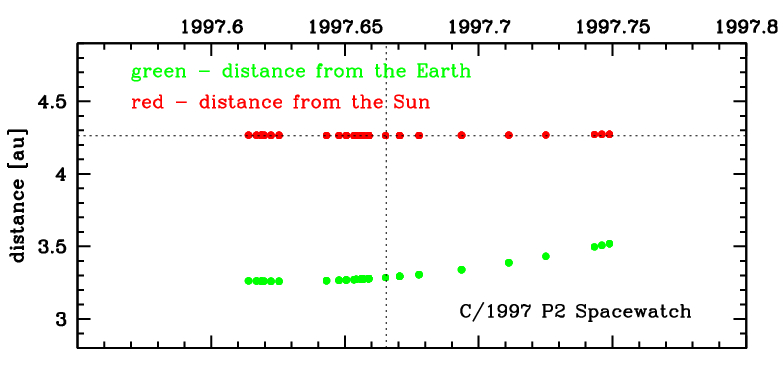C/1997 P2 Spacewatch
more info
Comet C/1997 P2 was discovered on 12 August 1997 at Kitt Peak (Spacewatch). It was then 2.5 weeks before perihelion passage; four days after itmade its closest approach to the Earth (on 16 August 1997, 3.26 au). Comet was observed 49 days (0.13 yr) in a narrow range of heliocentric distances: 4.267 au – 4.264 au (perihelion) – 4.272 au.
C/1997 P2 passed close to Jupiter six months before perihelion passage (0.652 au, 25 February 1997).
This likely Oort spike comet suffers strong planetary perturbations during its passage through the planetary system. These perturbations lead to escape of the comet from the solar system on hiperbolic orbit (see future barycentric orbit).
See also Królikowska and Dybczyński 2017.
C/1997 P2 passed close to Jupiter six months before perihelion passage (0.652 au, 25 February 1997).
This likely Oort spike comet suffers strong planetary perturbations during its passage through the planetary system. These perturbations lead to escape of the comet from the solar system on hiperbolic orbit (see future barycentric orbit).
See also Królikowska and Dybczyński 2017.
| solution description | ||
|---|---|---|
| number of observations | 95 | |
| data interval | 1997 08 12 – 1997 09 30 | |
| data type | perihelion within the observation arc (FULL) | |
| data arc selection | entire data set (STD) | |
| range of heliocentric distances | 4.27 au – 4.26 au (perihelion) – 4.27 au | |
| detectability of NG effects in the comet's motion | NG effects not determinable | |
| type of model of motion | GR - gravitational orbit | |
| data weighting | YES | |
| number of residuals | 184 | |
| RMS [arcseconds] | 0.59 | |
| orbit quality class | 2b | |
| previous orbit statistics, both Galactic and stellar perturbations were taken into account | ||
|---|---|---|
| no. of returning VCs in the swarm | 43 | |
| no. of escaping VCs in the swarm | 4958 | |
| no. of hyperbolas among escaping VCs in the swarm | 4245 | * |
| previous reciprocal semi-major axis [10-6 au-1] | -31.48 – -13.92 – 3.36 | |
| previous perihelion distance [au] | 11 – 14 – 16 | |
| previous aphelion distance [103 au] | 130 – 360 – 1900 | |
| time interval to previous perihelion [Myr] | 1.81 ± 0.098 | |
| percentage of VCs with qprev < 10 | 2 | |
| percentage of VCs with 10 < qprev < 20 | 98 | |
| previous_g orbit statistics, here only the Galactic tide has been included | ||
|---|---|---|
| no. of returning VCs in the swarm | 63 | |
| no. of escaping VCs in the swarm | 4938 | |
| no. of hyperbolas among escaping VCs in the swarm | 4252 | * |
| previous reciprocal semi-major axis [10-6 au-1] | -31.72 – -14.08 – 3.26 | |
| previous perihelion distance [au] | 11 – 14 – 16 | |
| previous aphelion distance [103 au] | 130 – 370 – 2000 | |
| time interval to previous perihelion [Myr] | 1.8 ± 0.098 | |
| percentage of VCs with qprev < 10 | 2 | |
| percentage of VCs with 10 < qprev < 20 | 97 | |
| percentage of VCs with qprev > 20 | 1 | |
